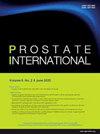Preoperative prostatic artery embolization before transurethral resection of the prostate for prostate glands larger than 80 mL: the first randomized controlled trial
IF 2.6
2区 医学
Q2 UROLOGY & NEPHROLOGY
引用次数: 0
Abstract
Background
This study aimed to evaluate the impact of preoperative prostate artery embolization (PAE) on intraoperative blood loss during transurethral resection of the prostate (TURP) in glands larger than 80 cc.
Material and methods
A prospective, surgeon-blinded randomized controlled clinical trial was conducted at a single tertiary center. Patients with a prostate volume of more than 80 cc with indications for TURP were randomized (1:1) to the following groups: preoperative prostatic artery embolization followed by TURP (Group A—intervention arm) and TURP alone (Group B—control arm). The primary outcome studied was blood loss measured as the drop in hemoglobin level postoperatively, and the secondary outcome measured was resection efficiency (resected weight per min) and postoperative complication rate.
Results
Our study included 10 patients each in group, A and B. The median prostate volume was 119 mL and 140 mL and the median preoperative hemoglobin was 13.3 g/dL (interquartile range: 12.5 – 14.3 g/dL) and 14.4 g/dL (interquartile range: 10.1–15.2 g/dL) in groups A and B, respectively. Change in postoperative hemoglobin was significantly greater in Group B than in Group A (−1.4 g/dL versus +0.5 g/dL, P = 0.015). There were no significant differences in the weight of resected prostate chips (52 g versus 73 g, P = 0.089) and resection efficiency (0.7 g/min versus 0.6 g/min, P = 0.853) between groups A and B. Two patients in Group B received one unit of red blood cell transfusion compared to only 1 patient in Group A (P = 1.000). One patient from each group had to be brought back to the operation room for hemostasis.
Conclusion
Our study demonstrated that preoperative prostate artery embolization reduces intraoperative blood loss in men with large prostates undergoing TURP but did not impact resection efficiency or complication rate.
前列腺≥80ml经尿道前列腺切除术前术前前列腺动脉栓塞:首个随机对照试验
本研究旨在评估术前前列腺动脉栓塞(PAE)对大于80cc腺体经尿道前列腺切除术(TURP)术中出血量的影响。材料和方法在单一三级中心进行了一项前瞻性,手术盲随机对照临床试验。前列腺体积大于80cc且有TURP适应症的患者按1:1的比例随机分为以下两组:术前前列腺动脉栓塞后行TURP治疗组(a组干预组)和单独行TURP治疗组(b组对照组)。研究的主要终点是术后血红蛋白水平下降的出血量,次要终点是手术切除效率(每分钟切除重量)和术后并发症发生率。结果A组和B组各10例患者,前列腺体积中位数分别为119 mL和140 mL,术前血红蛋白中位数分别为13.3 g/dL(四分位数范围:12.5 ~ 14.3 g/dL)和14.4 g/dL(四分位数范围:10.1 ~ 15.2 g/dL)。B组术后血红蛋白变化明显大于A组(- 1.4 g/dL vs +0.5 g/dL, P = 0.015)。A组和B组在切除的前列腺芯片重量(52 g对73 g, P = 0.089)和切除效率(0.7 g/min对0.6 g/min, P = 0.853)方面无显著差异。B组2例患者接受1单位红细胞输血,而A组只有1例患者接受1单位红细胞输血(P = 1.000)。两组各有一名患者被带回手术室进行止血。结论本研究表明术前前列腺动脉栓塞可减少大前列腺行TURP患者术中出血量,但不影响手术效率和并发症发生率。
本文章由计算机程序翻译,如有差异,请以英文原文为准。
求助全文
约1分钟内获得全文
求助全文
来源期刊

Prostate International
Medicine-Urology
CiteScore
4.40
自引率
26.70%
发文量
40
审稿时长
35 days
期刊介绍:
Prostate International (Prostate Int, PI), the official English-language journal of Asian Pacific Prostate Society (APPS), is an international peer-reviewed academic journal dedicated to basic and clinical studies on prostate cancer, benign prostatic hyperplasia, prostatitis, and ...
 求助内容:
求助内容: 应助结果提醒方式:
应助结果提醒方式:


